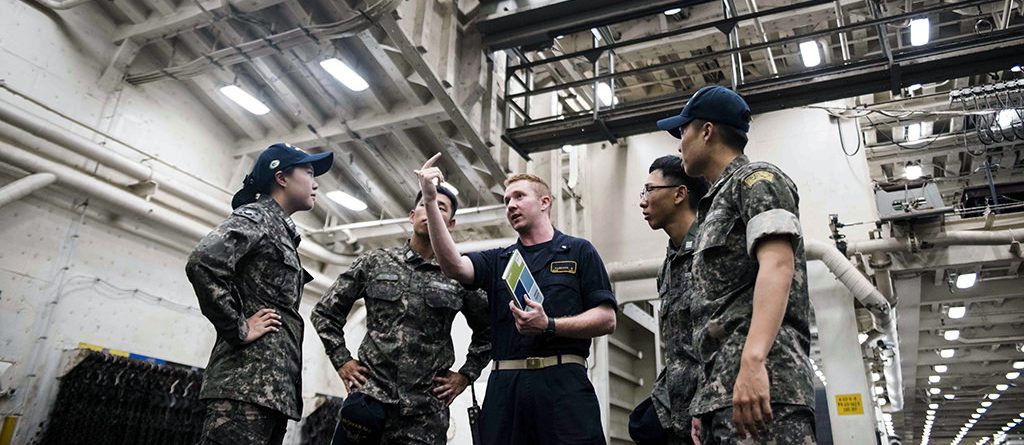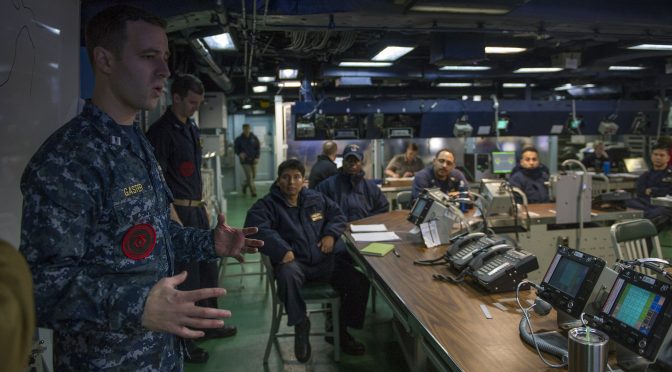Leadership Development Topic Week
By David Andre
“It’s not uncommon for discussions of competence and character to put the matters of creativity and compliance in tension…” — Admiral John Richardson, Chief of Naval Operations
In January 2017, Chief of Naval Operations Admiral John Richardson, released the Navy Leader Development Framework, outlining how the United States Navy will develop future leaders capable of meeting the challenges of a rapidly changing and complex world. The framework recognizes three values that are integral to developing leadership — compliance, creativity, and character. Of the three values, creativity represents the biggest challenge to naval leadership. It is challenging because it defies easy characterization and represents a divergence from the traditional values associated with developing Naval leadership. While there is an institutional framework and culture that develops, values, and supports compliance and character from seaman to admiral, the same cannot be said of creativity. Certainly creativity has always existed within the Navy, but until recently, it was not recognized as an integral value of leadership. Placing it on the same level as compliance and character requires change. And balancing the tension that exists between these values is one of the biggest challenges facing the Navy.
Creativity is More than just Being Different
In order to effectively harness creativity leaders must clearly understand what creativity is and how it differs from more traditional naval leadership values. Naval leaders are accustomed to dealing with issues of compliance and character. These values are well-defined within the Navy’s core values and evaluation process and feature prominently throughout a sailor’s career, regardless of rating or community. Naval culture views compliance and character dichotomously — one has either complied or not; one either has good character or not. In both instances, success and failure are easily identifiable. Leaders and followers feel comfortable using these metrics as ranking tools.
Creativity — using imagination or original ideas to create something — defies such simple characterization. Creativity is different; it is subjective and exists on a spectrum not seen with compliance and character. Creativity courts risk, is not easily manageable, and often results in failure. It follows that creativity will likely be costly in terms of resources and egos — there’s rarely an immediate payoff in any tangible terms. However costly, creativity and the innovation it sparks holds the key to developing future leaders that are adaptable. The creative mind holds multiple perspectives simultaneously. As such, creative decision-making produces more options, thereby increasing the likelihood of success. This idea is the bedrock for the SECNAV’s Naval Innovation Network, which seeks to bring together disparate ideas from across the ranks in the hopes of fostering creativity.
Establish a Direct Relationship with Creativity
While acknowledging the importance of creativity is important, leaders need to take concrete actions that encourage and make effective use of that creativity. The difficulty for today’s leaders is how to cultivate that creative environment for leaders and followers within an organization that traditionally measures success and failure objectively. Doing so requires adjustments to the way in which the organization reacts to failure and the way compliance and character are typically measured. These changes need to occur vertically as well as horizontally because, like character and compliance, when properly cultivated creativity is infectious.
Making creativity an effective part of the Navy’s leadership model presents some practical challenges. These challenges range from the bureaucratic to the operational and vary from community to community. While forward-leaning leaders speak of thinking outside the box, enlarging the box, or thinking like there is no box, the words can be difficult to translate into action. That is primarily because these well-intentioned challenges to become creative thinkers rarely address the practical limitations that box sailors in every day. From evaluation cycles and ranking boards to tour lengths and qualifications, the personnel organization of the Navy was not designed with creativity in mind. The bureaucracy, when coupled with operational tempos, stifles creativity; sailors simply don’t have the time or luxury to be creative. However, creativity must have time and room to flourish.
Creating this time and space within the disciplined constraints of the Navy is the primary issue facing today’s deckplate leaders. To meet this challenge, these leaders need to move beyond encouraging creativity and provide defined pathways through the bureaucracy and operational tempo. To create these pathways, it is essential that leaders first acknowledge the limitations and potential of creativity. Acknowledging limitations and potential allows leaders to adopt the CNOs line of effort toward High Velocity Learning, whereby leaders strive to accelerate learning through the adoption of the “best concepts, techniques, and technologies.” In doing so, leaders can set aspirational goals while ensuring that creativity yields results and is not wasted time.
Foremost, leaders need to identify where and when to tolerate creativity within their particular missions. A sailor performing a Planned Maintenance System (PMS) check is not an acceptable time for encouraging creativity. Yet, a junior officer conducting Theater Security Cooperation (TSC) activities or an Information Systems Technician identifying systems installations onboard a new platform could flourish in a creative environment. Making these differences clear to subordinates will set the stage for creativity to become an effective tool. Meanwhile, adapting processes outlined in the model of high velocity learning that embolden innovation and creativity will leave sailors feeling confident in exercising their creativity, while leaders will feel confident encouraging creativity.

Along with creating an environment conducive for creativity, leaders need to establish a balance between creativity and compliance. In many practical ways, creativity opposes the Navy’s concept of compliance. By its nature, creativity eschews following the standard rules as it searches for new and innovative ways to achieve something. Resolving the tension that exists between these values will involve sustained involvement from leadership. The CNO’s guidance makes specific mention of the tension created when the notions of competence and character meet the principles of creativity and compliance. Within this tension lies the potential for failure. There’s an immediate danger in too much creativity and not enough compliance, but there’s a long-term danger in too much compliance and not enough creativity.
Moving Past the Fear of Failure
Perhaps the greatest impediment to embracing creativity is the potential for failure. Fear of failure does more to stifle creativity than any bureaucracy or operational tempo ever can. The fear manifests itself in two distinct ways: individual and institutional. There is the individual fear that people have of failure and the repercussions of failure. And then there is the institutional fear that comes from the reticence that peers and leaders have of acknowledging failure in others. While each begets the other, it is important not to conflate the two because they come from different places and, thus, need different solutions. Institutional failure is abstract, while individual failure is personal. Studies show that followers who fear failure focus on that fear rather than the task, while leaders who fear failures tend to ignore the failures. In both instances, people lose the ability to learn lessons.
Therefore, mandating reforms to foster an institutional environment that embraces failure is only one part of the equation. The individual must also be convinced of the need to accept and learn from failure, which involves a more nuanced approach. To change the attitude sailors have toward failing the Navy must introduce the concept of failureship. Like the name implies, failureship is the ability to fail; and like leadership, it is a learned concept. Considering the relationship that people have with failure, learning to fail constructively is an important lesson for new sailors. Unfortunately, it’s a lesson that the Navy spends little time teaching.
Navy culture encourages success at every stage, and rightly so, because lives often depend on that success. The Navy cites historical examples of battles won and lost, each replete with astounding examples of sailors overcoming staggering odds and arduous circumstances to rise to the occasion. The CNO’s Professional Reading Program is replete with these stories of heroism. Often overlooked within these stories are examples of creativity—sailors taking chances when there’s nothing else to lose. While these tales illustrate that creativity can lead to success, there’s a deeper, less obvious lesson. That is, too often creativity is treated as a last-ditch effort, that failure is an acceptable outcome when there’s nothing else to lose. It is time to recognize that, in the proper context, creativity and failure will promote success. Creativity does not need to be reactive; it has a preventative dimension. It’s time to move failure to the forefront.
To promote this thinking, the discussion needs to move beyond mere acceptance of failure. It needs to move into a realm where leaders encourage failure and followers embrace the lessons of failure. Instead of getting over failure we need to rally around failure. As the aphorism goes: someone who’s never failed has never tried. Discussions of failure need to move from the posters and books and into wardrooms, messes, and galleys. This involves a paradigm shift in how the Navy treats failure. Unlike success, where we champion and personalize the effects, we take a distanced approach to failure. Failure, when accepted, is something that happens to others. Aside from these cultural biases, failure has psychological limitations—people have a tough time dealing with failure. For some, anonymity may encourage creativity, for others, the motivation to be creative may come from the promise of rewards. Despite these differences, the underlying premise remains the same—leaders must look for ways to foster creativity within themselves and their subordinates.
Conclusion
For good reason, the Navy has long promoted successful execution over thoughtful rumination. However, global forces are at work today that require a paradigm shift in the way the Navy develops future leaders. To remain on the cutting edge, keep the brightest talent, and sustain the element of surprise, the Navy needs to cultivate a culture that believes in the value of failure, adopts an organizational behavior that encourages creative minds, and balances the application of creativity with its practical limitations. After all, creativity embodies the Navy’s core values: it takes honor to try, courage to fail, and commitment to overcome failure.
While incorporating creativity into leadership development presents challenges, the good news is that the Navy already possesses many strengths and initiatives to leverage the creative spirit. From traditional concepts like intrusive leadership to new proposals like career sabbaticals and the Tours with Industry program, the Navy is well poised to begin developing creative leaders. The diversity of the Navy’s workforce is another key component that will bolster creativity through exchanging ideas and experiences. As the Navy strives to innovate and overcome, developing and sustaining creative thinkers will determine the future course.
LT David M. Andre is a former Intelligence Specialist, has served as an Intelligence Officer and Liaison Officer assigned to AFRICOM and is a graduate of the Naval Postgraduate School. He is currently serving as N2 for COMDESRON Seven in Singapore. He can be reached at DMA.USN@gmail.com. The views expressed above are his own and do not reflect the official views and are not endorsed by the United States Navy, the Department of the Navy, the Department of Defense, or any other body of the United States Government.
Featured Image: February 7, 2017. A warfare tactics instructor speaks before sailors. (U.S. Navy photo)


A very interesting discussion about leadership. What I am missing so far is the question about emotional competence of a leader.